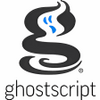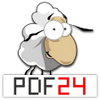PDF converter with a simple command-line interface
PDF converter with a simple command-line interface
Vote: (7 votes)
Program license: Free
Developer: Ghostscript
Version: 10.0.0
Works under: Windows
Vote:
Program license
(7 votes)
Free
Developer
Version
Ghostscript
10.0.0
Works under:
Windows
Pros
- Highly efficient rendering of PDFs with transparency
- Generates PDF/X-3 compliant documents
- Supports advanced color handling with DeviceN
- Compatible with older Windows versions
- Light on system resources
Cons
- Command-line interface might be challenging for some users
- Lacks updates and could have security implications
- User interface not as polished as contemporary software
- May require third-party GUI for less technical users
AFPL Ghostscript is a comprehensive, open-source interpreter for Postscript languages and Portable Document Format (PDF) files. It's a valuable utility for users needing to process, convert, and view PS and PDF files.
Performance and Features
Ghostscript serves as a powerful engine underpinning a variety of software applications that deal with PDF and Postscript documents. It's particularly favored for its capabilities in rasterizing or rendering page descriptions into images. For those dealing with complex documents, including graphics with transparency, AFPL Ghostscript offers impressive rendering enhancements that significantly reduce processing time. This can result in speed improvements ranging from tenfold to ninetyfold, which is particularly beneficial when working with files containing numerous layers of transparencies.
Additionally, it boasts robust bug fixes and improvements over its iterations, with special attention given to DeviceN (spot color) handling and the PDF interpreter, which stand out as notable upgrades for users requiring precise color management and PDF file manipulations.
AFPL Ghostscript's pdfwrite device is adept at generating PDF/X-3 compliant documents. This feature is indispensable for professionals in the printing and graphics industry where adherence to such standards is a strict requirement.
The beta version of the ps2write output device is another highlight, capable of generating higher-level Postscript that includes well-formed text and graphics. This is significant for users who need to convert between PDF and Postscript formats without losing the quality or structure of the original documents.
Usability and Accessibility
The interface of Ghostscript is less about visual appeal and more about functionality. Operating mostly via command line, it appeals to users who are familiar with technical computing environments. Nonetheless, it’s a versatile tool that can be used indirectly through several third-party graphical interfaces that rely on its processing capabilities.
As of its version 8.60, released back in August 2007, Ghostscript remains a stalwart solution, although it might not have the contemporary polish of newer software. It maintains compatibility with Windows systems as far back as Windows 98, ensuring legacy devices can still benefit from its features.
The program's space requirements are modest, making it a suitable choice for systems with limited storage. However, users should note that the lack of frequent updates could imply potential security vulnerabilities, so utilizing it within modern, secure environments is advisable.
Conclusion
AFPL Ghostscript is a trusted companion for users needing to navigate the complexities of Postscript and PDF documents. While it may lack the freshness of regularly updated software, its performance enhancements and solid feature set maintain its position as a valuable tool in specific professional contexts.
Pros
- Highly efficient rendering of PDFs with transparency
- Generates PDF/X-3 compliant documents
- Supports advanced color handling with DeviceN
- Compatible with older Windows versions
- Light on system resources
Cons
- Command-line interface might be challenging for some users
- Lacks updates and could have security implications
- User interface not as polished as contemporary software
- May require third-party GUI for less technical users




